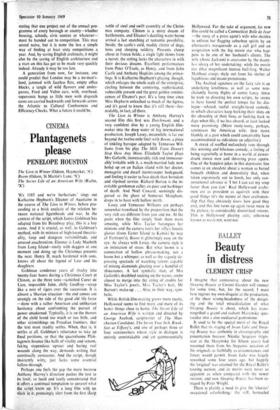Beauty in distress
BALLET CLEMENT CRISP
I imagine that controversy about the new Sleeping Beauty at Covent Garden will simmer for some time, but, for the record, I must here register my own disquiet at the production, at the sheer wrong-headedness of the design- ing and the total miscalculation of what Sleeping Beauty is about, which has trans- mogrified a grand and radiant Maryinsky spec- tacular into a dim mediaeval pantomime.
It used to be the special merit of the Royal Ballet that its staging of Swan Lake and Sleep- ing Beauty was authentic in choreography and presentation because Nicolai Sergeyev (regis- seur at the Maryinsky for fifteen years) had mounted them from his Stepanov notation of the originals as faithfully as circumstances and forces would permit. Swan Lake was lirgely reworked some four years ago, but happily the 'original' was retained for the Royal Ballet's touring section, and its merits were never so apparent as when compared with the newer version; and now Sleeping Beauty has been re- staged by Peter Wright.
There is plainly a need to give the 'classics' occasional refurbishing: the stiff, barnacled
paraphernalia of the old-style production can look desperately creaky and foolish to modern eyes, and Wright's recent and beautiful Giselle for the touring section showed how an old ballet could be enhanced by sensitive and apposite production. But, though Wright has been careful to preserve the Petipa choreo- graphy, it is so obfuscated by the designing (de Nobili and Dobujinsky for costumes, Bar- don for sets) and so sabotaged by being trans- posed to a Victorian Gothic world, that the brilliance and beauty of Petipa's inventions have been dimmed and even the Tchaikovsky score now seems at odds with the stage action.
The idea behind the production was appar- ently to make the story more touching and coherent, and herein lies the fault. Beauty is not a dramatic ballet that needs this sort of `humanising'; unlike the romantic Giselle, which flowered under this treatment, Beauty is hardly a dramatic ballet at all. It is a formal and magnificent display, the most opulent and dazzling of court entertainments from an opu- lent and dazzling time. It was meant to pander to the splendour of the Tsarist court; its creator, 1. A. Vsevolozhsky, Director of the Imperial Theatres, propounded a gorgeous tribute to the Absolute Monarchic ideal— hence the second half of the work was set at the most absolutely monarchic . of periods, the court of Louis XIV. To bring it forward in time—as Kenneth MacMillan very success- fully did in his Berlin staging last year, so that the Awakening takes place in 1890 at the time the music was composed—and to set it with stunning pomp and Faberge luxury, made good sense; but to transfer it to the musty monochrome of the de Nobili / Bardon Middle Ages is deadly dull.
Everything looks faded; in America furni- ture is subjected to an artificial `antiquing' process and is then said to be 'distressed,' and our new Beauty is very distressed indeed. The designs, owing much to the engravings of Gustave Dore, look dowdy and cumbrous; the men seem heavyweight and portly, the long- legged girls, in Coppelia-length tutus, turn into dachshunds; the dreary creams and ivories and browns absorb light like so much blotting- paper. The sets follow a descending curve of unsuitability, passing from a disused quarry for the hunting scene to the claustrophobic horrors of the final red tent that clamps down on the dances as if they were being squashed under a blood-orange.
The net result is that the grandeur of the work has been 'domesticated' out of existence; the magic has disappeared, and so 'tasteful' is the blending of costumes into sets that the dances disappear too. The alterations and addi- tions in the choreography add little to the work; there is even a beautiful new Awakening pas de deux that is too lyrical in style for the rest of the ballet, and that somehow detracts from the impact of the final great adagio, and the hunting scene, which can be a delight (Mac- Millan turned it into a ravishing winter sequence of furs and sledges and imperial melancholy), is so abbreviated as to make little sense.
So what is to be done? Expensive and taste- less, the production might be expected to have to last—as the (retrospectively) mar- vellous Messel one did—for twenty years. But this is unthinkable. How long before the Carabosse curse is lifted? Perhaps those twin princes, John Field and Kenneth MacMillan, will awaken the Beauty in 1970. I certainly hope so.



































 Previous page
Previous page